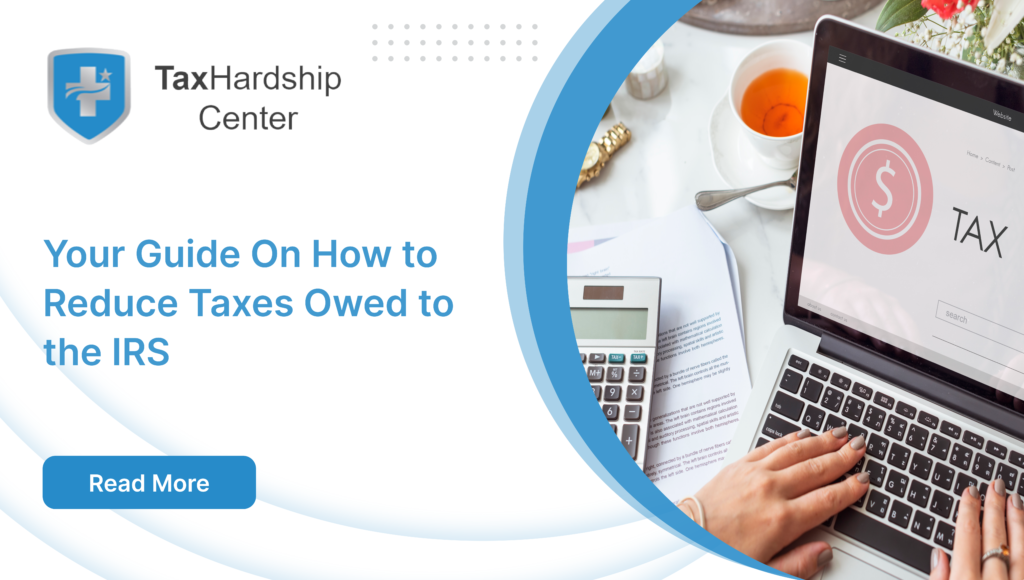Paying taxes is a duty that comes with financial responsibility, but you can still employ strategies to reduce your tax bill. Understanding the tax code and making informed decisions can produce a more favorable financial outcome. This blog post will explore five easy ways to lower your taxable income this year and discuss related topics that may impact your tax situation. Let’s dive into the details to save money on your taxes.
Need help with tax woes? The Tax Hardship Center is your ally, offering nationwide, hassle-free assistance to conquer your IRS challenges. Our experts provide a free consultation, ensuring personalized solutions tailored to your unique situation. With our 14-day money-back guarantee, you have nothing to lose but your tax stress. Partner with us for peace of mind and let our team navigate the complex tax landscape for you. Take the first step towards financial liberation—contact Tax Hardship Center today!
5 Easy Ways to Lower Your Taxable Income in 2024
1. Contribute to a 401(k) or Traditional IRA
Investing in a secure retirement future is undeniably crucial, and it comes with the added benefit of current tax savings. Whether you choose a 401(k), mainly if one is available through your employer or a traditional IRA, these contributions can lower your gross income, lowering your taxable income for the year.
Minimum Deposit and Balance
Different retirement plans have varying requirements regarding minimum deposits and balances. For example, whereas a 401(k) plan sponsored by an employer usually does not have a minimum balance requirement, an individual retirement account like a traditional IRA might require a minimal initial deposit to be established.
Investment Vehicles
The beauty of these retirement accounts lies in their versatility. You can select from various investment vehicles, such as stocks, bonds, mutual funds, and exchange-traded funds (ETFs). You can tailor your investments within your retirement account accordingly, adhering to your financial objectives and risk tolerance.
Investment Options
These retirement accounts offer a broad spectrum of investment options. Diversifying your investments reduces risk and increases the potential for returns as you consider your long-term retirement horizon.
Educational Resources
Numerous financial institutions, including Fidelity Investments, offer comprehensive educational resources. These can help you make the most informed decisions regarding your retirement savings plan and ensure that your contributions align with your overall retirement goals.
2. Enroll in an Employee Stock Purchasing Program (ESPP)
Participation in an ESPP allows employees to purchase company stock at a reduced rate. This purchase discount can effectively act as a form of tax-deferred compensation since it reduces the amount of income subject to immediate taxation. Depending on the company’s specific plan, this discount can range from a modest 5% to an impressive 15% or even more.
ESPPs work by withholding a portion of your post-tax salary over a set period, known as an offering period, which typically spans six months to a year. At the end of this period, the company will use the accumulated funds to purchase stock on your behalf at the predetermined discount rate.
Tax Advantages
The primary tax benefit of an ESPP lies in the potential for tax deferral. While the discount on the stock is considered part of your compensation, you do not pay taxes on this discount until you sell the stock. If you meet specific holding period requirements—holding the shares for at least one year after purchase and two years after the beginning of the offering period—the profit over the discounted price is taxed at the long-term capital gains rate, which is lower than the ordinary income tax rate.
3. Contribute to a Health Savings Account (HSA)
An HSA is an excellent vehicle for saving funds for future healthcare expenses while reducing your taxable income. You contribute with pre-tax dollars, and the funds grow tax-free as long as withdrawals are used for qualified medical expenses.
Tax Benefits
The contributions to an HSA are made with pre-tax dollars, which lowers your taxable income. In 2023, an individual can contribute up to $3,850, and a family can contribute up to $7,750. Individuals age 55 and older can make an additional catch-up contribution of $1,000. These contribution limits are typically adjusted annually for inflation.
The tax advantages of HSAs are threefold: the money you contribute to the account reduces your taxable income, the funds grow tax-free, and withdrawals for qualified medical expenses are tax-free.
Qualified Medical Expenses
Funds from an HSA can be used for various expenditures, including deductibles, copayments, coinsurance, and other medical expenses that your health plan does not cover. However, the IRS defines qualified medical expenses, so using the funds appropriately is essential to avoid potential taxes and penalties.
Long-Term Savings
Unused funds in an HSA roll over from year to year, so there’s no pressure to spend down the balance. This rollover feature makes HSAs an excellent tool for long-term healthcare savings, even saving for medical costs in retirement. Some HSAs even allow you to invest your contributions, which could increase your savings by growing funds in a retirement account.
4. Deduct the Student Loan Interest You’ve Paid
For those saddled with student debt, the IRS permits a deduction for the interest paid on student loans, assuming you meet specific income criteria. While various factors determine eligibility, this deduction can allow you to subtract a portion of the interest paid during the year from your taxable income, thus lowering your overall tax liability.
5. Sell Losing Stocks
Investors can use a strategy called tax-loss harvesting to lower their taxable income. Selling securities that have experienced a loss could offset any realized capital gains you have from other investments. If your losses exceed your gains, you can use the excess to reduce your other taxable income with certain annual limits. In some cases, if your losses are significant, you can carry over the unused portion into subsequent tax years.
Minimum Deposit and Balance
When setting up an investment account to trade stocks, be aware of the minimum deposit and balance requirements, which vary by brokerage firm. It’s essential to familiarize yourself with the terms of your chosen platform.
Investment Vehicles
A well-rounded investment portfolio encompasses various investment vehicles, such as individual stocks, ETFs, and mutual funds, enabling you to manage risk and tailor investments to your long-term financial aspirations.
Investment Options
Align your stock portfolio with your investment strategy, which may lean towards aggressive growth or conservative, steady income. Your choice of stocks or other securities should reflect your financial goals and investment timeline.
Does Contributing to a 401(k) Reduce Your Taxable Income?
Indeed, contributing to a 401(k) plan can reduce your taxable income. Since these contributions are made with pre-tax dollars, they decrease the income reported to the IRS, lowering your immediate tax liability.
What Factors Affect Income Tax?
The income tax you owe yearly doesn’t solely hinge on your earnings. It’s shaped by a tapestry of factors that interact to determine your final tax liability. Here’s a deeper look into the elements that impact your income tax:
Total Income
All income sources are accounted for when determining your tax obligation. This includes wages, salaries, bonuses, tips, and income from investments such as interest, dividends, capital gains, and any income from rental properties or business activities. Generally, the higher your income, the more taxes you’re likely to pay, but it could be more straightforward due to the other factors at play.
Federal Income Tax Rates
The United States employs a progressive tax system, meaning different portions of income may be taxed at varying rates. These escalating rates are known as marginal tax rates. The rate that applies to your highest dollar of income is your marginal tax rate, which can give you a sense of how much tax you’ll pay on additional income.
Tax Brackets
Your tax bracket correlates with your taxable income and filing status, such as single or married filing jointly. Since tax brackets are incremented, only some of your income will be taxed at the same rate. Instead, each portion of your income up to a certain threshold is taxed at its respective bracket rate. Understanding which tax bracket you fall into can be critical for tax planning.
Tax Credits and Deductions
The federal tax code provides a variety of tax credits and deductions, both of which can significantly lower your tax obligation. Credits are precious as they reduce your tax bill dollar for dollar. Common credits include the child tax credit, earned income tax credit, and education credits. Deductions reduce the income subject to tax and can consist of standard deductions, itemized deductions such as mortgage interest or charitable contributions, and deductions for contributions to retirement accounts and HSAs.
Filing Status
Whether you’re filing singly, as the head of household, jointly with a spouse, or separately as a married couple, your filing status influences your tax brackets and can affect the credits and deductions you can claim.
Additional Taxes
Additional taxes, such as self-employment tax, the alternative minimum tax, and taxes on unearned income for dependents (Kiddie Tax), can also apply, depending on your financial situation.
Conclusion:
Optimizing your tax strategy can lead to significant savings and financial security. Leveraging tax-saving opportunities like retirement contributions, stock programs, and deductions can lower your taxable income and maximize your overall economic well-being. Understanding the tax code and exploring various tax-reduction strategies empowers you to make informed decisions and achieve your financial goals.
Why Tax Hardship Center?
1. Hassle-Free Assistance:
Say goodbye to sleepless nights and endless tax-related stress. At the Tax Hardship Center, we believe in simplifying the complex. Our team of experts is dedicated to guiding you through every step of the process, ensuring that your tax concerns are met with precision and care.
2. 14-Day Money Back Guarantee:
We’re so confident in our ability to ease your tax worries that we offer a 14-day money-back guarantee. If, for any reason, you’re not satisfied with our service, we’ll gladly refund your investment. Your peace of mind is our top priority!
3. Free Consultation:
Are you curious about how we can transform your tax experience? Book a free consultation now! Our team will assess your situation, answer your questions, and provide free insights tailored to your needs.
4. Nationwide Coverage:
No matter which corner of the United States you call home, the Tax Hardship Center covers you. We proudly serve all 50 states, bringing our expertise to your doorstep. Wherever you are, our commitment to excellence follows.
FAQs:
1. Does Contributing to a 401(k) Reduce Your Taxable Income?
Yes, contributing to a 401(k) lowers your taxable income since these contributions are made with pre-tax dollars. You decrease your immediate tax liability by reducing your reported income to the IRS.
2. What Factors Affect Income Tax?
Income tax owed is influenced by various factors, including total income, federal income tax rates, tax brackets, tax credits, deductions, filing status, and additional taxes like self-employment tax or the alternative minimum tax. Understanding these factors helps in tax planning and optimizing your tax strategy.
3. How Can I Lower My Taxable Income?
You can lower your taxable income through strategies such as contributing to retirement accounts like a 401(k) or IRA, participating in employee stock purchasing programs (ESPPs), contributing to a health savings account (HSA), deducting student loan interest, and utilizing tax-loss harvesting by selling losing stocks.
4. What Are the Benefits of a Health Savings Account (HSA)?
HSAs offer several benefits, including contributions made with pre-tax dollars, tax-free growth of funds, and tax-free withdrawals for qualified medical expenses. Unused funds roll over yearly, making HSAs valuable for long-term healthcare savings.
5. How Does Tax-Loss Harvesting Work?
Tax-loss harvesting involves selling securities that have experienced a loss to offset realized capital gains, thus lowering your taxable income. Any excess losses beyond gains can be used to reduce other taxable income with certain annual limits. This strategy can help minimize taxes on investment returns.








